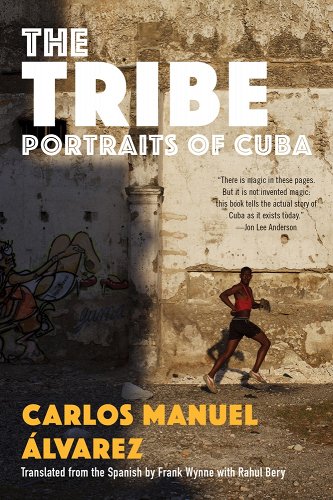[ad_1]
In the nineteen journalistic profiles that comprise The Tribe: Portraits of Cuba, Carlos Manuel Álvarez represents cross sections of Cuban life. Translated from Spanish by Frank Wynne and Rahul Berry, Álvarez’s literary portraits depict, among others, the New York Yankees pitcher José Contreras, the dissident poet Rafael Alcides, a migrant couple fleeing through Central America, college students selling food on the black market, and the underclass living next to the Bote de Cien landfill. Álvarez grounds his mosaic in a focus on ordinary people and their perceptions of the country they live in or have left. What emerges is a sense of in-between-ness and displacement that binds them together.
Álvarez depicts geographic displacement when he documents the journey of two young Cubans, Carmona and Ibelys, through Central America to Mexico. Eventually they hope to reach Atlanta, where Carmona’s sister is waiting for them. Álvarez also interviews Boris Santiesteban, who was intercepted by a rescue helicopter and transported to a detention center when he tried to make the journey to Miami through shark-infested waters. Santiesteban is representative of thousands of Cubans who tried to reach Florida by raft under the United States’ “wet foot, dry foot” policy, which the Obama administration ended in 2017. Álvarez profiles Charles Lee Hill, too. A U.S. citizen wanted by the FBI who fled to Cuba in 1971, Hillhas lived in Cuba for decades as a refugee. Of people like these caught in various states of in-between, Álvarez remarks that “a migrant has not truly left his country until he finally arrives at the place he wants to be. The migrant’s journey is a curious form of purgatory, no matter how far he travels or how terrible the journey, and for as long as he is traveling, the migrant is still in limbo.”
Álvarez considers more abstract examples of limbo in his portraits of Cuba, too. Many people are stuck on either side of the United States Cuban Assets Control Regulations, which effectively prohibits travel between the U.S. and Cuba. Cubans who immigrated to Miami have been unable to return, and those who stayed in Cuba have been unable to reach loved ones in the United States. Álvarez also profiles Cuban citizens, like the poet Rafael Alcides, who have spent their lives waiting for the unfulfilled promises of the Revolution: the better life that never materialized.
A journalistically rigorous picture of Cuban life, The Tribe is characterized by the gaps between Álvarez’s subjects. Using interviews and on-site reportage, Álvarez profiles people from various socioeconomic backgrounds, with contrasting political affiliations. The sketches he compiles demonstrate a wide range of experiences and perceptions of Cuba. Álvarez allows the juxtapositions between these profiles to reveal a country that looks different from person to person. And he prevents the reader from reaching too settled a definition of Cuba. A nation is, after all, nebulous—the only way to make an honest portrait is to approach it from myriad perspectives. In The Tribe, the resulting mosaic is rich for its nuance and contradictions.
Carlos Manuel Álvarez parallels the in-between-ness of his subjects by engaging fluidly with genre. The Tribe: Portraits of Cuba, which Álvarez published in 2017, employs the Latin American crónica form, blending journalism and narrative nonfiction with fiction techniques. Álvarez has since published two novels that explore the same themes of displacement and limbo that he introduced in The Tribe. Álvarez uses tools of journalism and fiction, eschewing genre boundaries, to untangle and apprehend Cuba. His ability to work from both genres produces a compelling, nuanced portrait of Cuban life.
Álvarez is uniquely qualified to do this project because he can and does leave Cuba. Dividing his time between Mexico City and Havana, he regularly traverses the boundaries that separate these countries. The flights back and forth that he describes in The Tribe represent a negotiation of geographic borders and of the more abstract relationship between old-home and new-home, here and there. Of one such journey to Mexico City, he writes that “in an hour and a half, my flight to Mexico City would take off. I desperately wanted to go back.” Once back in Mexico, he continues to write about Cuba.
I read The Tribe in the United States, where legal and linguistic barriers keep me from reaching Cuba. U.S. government sanctions prevent anyone from crossing in either direction. And even when outsiders do visit Cuba, Álvarez suggests, they do not really see it. The Havana tourists frequent is not the Havana Cubans live in. I read The Tribe in translation, too, so I experienced a version of Álvarez’s portrait that has been mediated and rearticulated into English by Frank Wynne and Rahul Berry. Because it has been five years since La Tribu was first published in Spanish, however, I encounter The Tribe at the delay that is tragically typical for Spanish-language literature to reach Anglophone markets. And translation does not permeate boundaries so much as it circumvents them: Wynne and Berry’s translation is distanced temporally and linguistically from Álvarez’s original text, which is necessarily separate (as writing always is) from its subject: a nation in flux. A reader in translation, especially within the United States, can get closer but never arrive.
The Tribe ends, aptly, in limbo. In the final profile, this time of himself, Álvarez has been cleared by customs to leave Havana but has not yet reached his destination Mexico City. He is like the migrant who “has not truly left his country until he finally arrives at the place he wants to be.” In moments of displacement like this one, Álvarez explains, there is “a rift in reality, such that you arrived at a place as you were leaving it.” To be in Cuba, you must leave; to be anywhere, you must be nowhere at all. “The flight took off,” Álvarez writes, and “I closed my eyes and allowed myself to glide into the lofty darkness of nowhere in particular. What had been was outweighed by what was yet to come.” Displacement is a state of unlimited potential: when you are nowhere, you could be anywhere. The Tribe: Portraits of Cuba depicts a Cuba in-between, haunted by infinite possibilities.

Nonfiction
The Tribe: Portraits of Cuba
By Carlos Manuel Álvarez
Graywolf Press
June 21, 2022

[ad_2]
Source link

